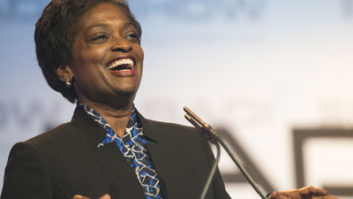Ben Downs is vice president and general manager of Bryan Broadcasting, a central Texas-based radio group owner. The company has struck up a partnership with Texas A&M University on something called “Fusion FM.”

Caitlin Curbello in the Fusion FM Studio Photo Dave McDermand/The Eagle
Radio World: What is the “Fusion FM” project?
Ben Downs: For some time everyone in the industry has worried where the next generation of broadcasters is coming from. A little over a year ago as part of a project, a student at Texas A&M, Caitlin Curbello, developed a new music format she called “Divergent Rock.” She asked our opinion and wondered if there was a way it could ever become a commercially-viable product. As discussions took place, we saw an opportunity to turn our HD2 channel over to the radio classes at the Texas A&M Agriculture Leadership and Communications Department to develop an academic curriculum around real-world broadcast experience.
They built a studio and developed a classroom curriculum for students. As you can see by the studio picture … they’re serious about the students getting real world experience. We agreed that the professors would teach and the station would mentor students in all aspects of privately-owned, commercial radio.
In addition to the on-air component, the station streams online and via a smartphone app.
RW: What kind of education and experience can be learned by students at Fusion FM?
Downs: We want it to be as realistic as it can be within the confines of a semester schedule (that means we also have to cover the weeks between semesters). Most students are interested, of course, in the fun DJ and music programming side. But we’re giving them full-immersion. They have their own music scheduling software and as the program grows, the students will be involved in all aspects of running a radio station — from promotions, to advertising, to regulatory paperwork to selling ads. We plan for the students in the radio classes to get the entire experience of what is involved in keeping a station on the air. Our Operations Director Tucker Young schedules our staff to speak to the classes and volunteer for mentoring.
One unexpected hands-on learning opportunity is play-by-play sports and sports coverage. As a member of the SEC, Texas A&M has a major NCAA sports program. A lot of students express an interest in someday being sports broadcasters. We’ve made arrangements with TAMU to allow the students access to broadcast the Olympic sports and some high school sports as well. We’re matching up their interest with the reality of live sports coverage. Using a Comrex Access system they establish a connection and go on-air with play-by-play, color and stats. If the system goes down, they have the opportunity to troubleshoot and restore the connection just like dozens of play-by-play teams do every Friday night.
RW: What are the benefits of this private-university co-op and can it be replicated by other companies and schools?
Downs: It required a pretty deep breath for me to watch as we cut over the transmitter feed from our studio to the student-run studio. Their equipment is top-notch, but we know they are learning their craft. And as the licensee we’re still responsible for what they do. We’re lucky that the professors involved all have broadcast experience. By providing the mentoring, we put ourselves between on-the-air and a lot of rookie mistakes. The mentoring includes air-checks and reviews. One blog suggested this fulfills two important pieces of the 21st century radio puzzle: where do new, trained, announcers come from, and what kind of format would millennials program if somebody gave them a radio station to learn with.

I want to add an unexpected statistic. Before our involvement with this program we were hiring their graduates without knowing they were Agricultural Leadership and Communication grads. One day someone brought a cake for the grads of their program for a little celebration and when I counted … We at Bryan Broadcasting had hired 13 of our 76 employees from that department. And we didn’t even know it. Since they were that good, we thought this would be a great place to help develop the next generation of broadcasters.
RW: Fusion FM is on an HD Radio subchannel. How practical is that really or is it a great use of HD Radio subchannels?
Downs: Today there are 20 million car radios that receive HD broadcasts. But, we also make sure we’re all over the streaming world. We’re available at RadioAggieland.com, TuneIn, and the station website FusionRadioHD.com. Certainly more people would hear the station if we put it on the main analog channel, but that one supports Bryan Broadcasting.
Having said that, we argue that starting on an HD channel is akin to the time when broadcasters got their start on small town stations and worked their way up. With the advent of voice tracking and automation that small market experience is found less and less. Using an HD/streaming model allows these students to learn, make mistakes and grow in their craft with less worry about ratings and revenue. But, again, this is a private, commercial, over-the-air station … so content matters.
RW: Texas A&M seems to be aggressively building its radio education programs and utilizing more tools, what’s behind that push?
Downs: A&M has taken a different position than most. While there is still a lot of classroom learning associated with this program, they don’t just put students on a two-hour weekend show on a noncommercial station. They push them hard to learn it all. Announcing, scheduling, promoting, selling, and engineering … all aspects. Recently, the students even did their first live remote from an event on campus. Soon they’ll be doing play-by-play of soccer and volleyball games. And next fall we hope to have their broadcast teams working in parallel with our teams to go on the air with high school football games. And in Texas, that’s a big step.

The Fusion FM Studio










